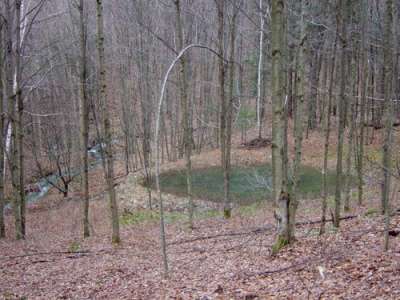Stewardship Stories - Readers Share Their Ideas and Projects
In the fall of 2007, with support from the U.S.D.A.’s Wildlife Habitat Improvement Project (WHIP), we installed seven vernal pools of varying sizes on our 410-acre property in North Bennington, Vermont. Our goal was to enhance our property for all sorts of wildlife, including amphibians. The construction was done with an excavator and, in some cases, the front-end loader of my tractor.
The excavations took only three days. Some of the pools were put in the woods and some of the pools were sited at wet areas on the edge of the woods. After the dirt work, we “brushed in” the pools with willow wisps and patches of red osier; willow cuttings were taken in spring and inserted into the wet ground at the edge of the vernal pools. We planted these pool-side plants to provide shade to keep the water cool; they’ll also serve as cover for the amphibians traveling to the pools to breed. We added some aquatic plants from our pond to the pools, mainly coontail, which provide some cover in the water and a source of nutrients for the inhabitants.
Some of these pools will probably not dry up, unless the late summer is particularly dry, because they are fed by small springs. The area where the pools are sited is surrounded by wooded ridges, and there is an underlying soil layer of clay. Thus, ground water is often near or on the surface. Some small brooks that drain into the hollow where our property lies contain small brook trout, but we took care to ensure that the pools were not sited nearby so that fish would not become established.
The vernal pools are shallow, with the deepest sections in a few pools only between 2 and 3 feet deep. The smallest pools are only about 100 to 200 square feet, and the largest is about 6,000 square feet, with a small island in the middle.
The first spring (2008), we were already seeing tadpoles, presumably from some green frogs that had colonized the pools shortly after we’d built them. Some of the egg masses that spring were attached to the large sticks that we threw into the water for that purpose. In the spring of 2009, we were hearing wood frogs and spring peepers singing.
Amphibians are experiencing a worldwide decline, and improving your own land as habitat for them is rewarding for both you and the species that will benefit. It is wonderful to experience the chorus of singing frogs and toads each spring on a warm and wet evening. —
A version of this story first appeared in the Vermont Coverts newsletter.


